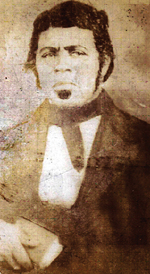Paul Jennings | |
|---|---|
 Jennings c. 1850s | |
| Born | c. 1799 |
| Died | 1874 (aged 74–75) |
| Occupation(s) | American enslaved abolitionist Author |
Paul Jennings (c. 1799–1874) was an American abolitionist and writer. Enslaved as a young man by President James Madison during and after his White House years, Jennings published, in 1865, the first White House memoir.[1] His book was A Colored Man's Reminiscences of James Madison, described as "a singular document in the history of slavery and the early American republic."[2]
Living in Washington, D.C., from 1837 on, Jennings made many valuable connections and was aided by the northern Whig Senator Daniel Webster in gaining freedom. In the 1850s, Jennings traveled to Virginia, where he tracked down his children, who had grown up on a neighboring plantation with his wife, Fanny, who was also enslaved. His relatives on his mother's side were sold by the widow Dolley Madison with Montpelier in 1844. His three sons joined the Union cause during the American Civil War.
In 2009, his descendants were honored at Montpelier after a lecture on Jennings. They were also invited to a private viewing at the White House of Gilbert Stuart's 1796 portrait of George Washington.
- ^ Swarns, Rachel L. (August 15, 2009), "Madison and the White House, Through the Memoir of a Slave", The New York Times, retrieved 2009-08-24
- ^ Annette Gordon-Reed, "Foreword", to Elizabeth Dowling Talyor, A Slave in the White House: Paul Jennings and the Madisons, New York: Palgrave Macmillan, 2012
© MMXXIII Rich X Search. We shall prevail. All rights reserved. Rich X Search
